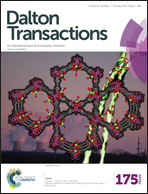Sterically-constrained tripodal phosphorus-bridged tris-pyridyl ligands†
Abstract
Introducing substituents into the 6-position of the 2-pyridyl rings of neutral tris-pyridyl phosphanes of the type P(2-py′)3 (where 2-py′ is a substituted 2-pyridyl ring), has a marked impact on their coordination of transition metal ions, as revealed in the current study. Whereas the unsubstituted phosphorus-bridged tris-pyridyl ligand P(2-py)3 (1) forms the sandwich cation [{P(py)3}2Fe]2+ (4) with iron(II), coordinating via all of the donor nitrogen atoms, the reaction of the methyl-substituted counterpart P(6-Me-2-py)3 (2) and FeCl2 results in the half-sandwich arrangement [{P(6-Me-2-py)3}FeCl2]·toluene (5·toluene), in which only two N-atoms of the ligand coordinate to the metal. A similar half-sandwich type complex, [{P(6-Me-2-py)3}FeCl(OTf)]·2THF (6·2THF), is obtained from reaction of 2 with Fe(OTf)2 in the presence of LiCl, only now with all three of the N-atoms of the ligand coordinated to FeII. The formation of a half-rather than full-sandwich complex with 2 suggests that steric clashing of the Me groups prevents the formation of sandwich-type arrangements. The reaction of [Cu(MeCN)4]PF6 with P(6-Me-2-py) (2) gives the complex [(MeCN)3Cu{P(6-Me-2-py)3}Cu(MeCN)](PF6)2 (7), in which two CuI atoms are coordinated by the bridgehead P-atom and by the three N-atoms of the tris-pyridyl ligand (a unique coordination mode in this area). Overall, the results indicate that 6-Me substitution results in a promising 6-electron capping ligand for organometallic synthesis and catalysis.


 Please wait while we load your content...
Please wait while we load your content...